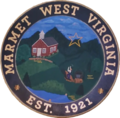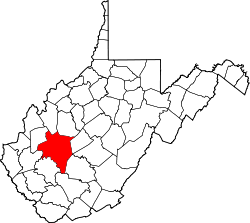Town of Marmet | |
|---|---|
Town | |
 Location of Marmet in Kanawha County, West Virginia. | |
| Coordinates: 38°14′43″N81°34′3″W / 38.24528°N 81.56750°W | |
| Country | |
| State | |
| County | Kanawha |
| Incorporated | 1921 [1] |
| Government | |
| • Mayor | Frances Armentrout |
| Area | |
• Total | 1.41 sq mi (3.65 km2) |
| • Land | 1.27 sq mi (3.30 km2) |
| • Water | 0.14 sq mi (0.35 km2) |
| Elevation | 610 ft (186 m) |
| Population | |
• Total | 1,501 |
| 1,473 | |
| • Density | 1,072.6/sq mi (414.13/km2) |
| Time zone | UTC-5 (Eastern (EST)) |
| • Summer (DST) | UTC-4 (EDT) |
| ZIP codes | 25315, 25365 |
| Area code | 304 & 681 |
| FIPS code | 54-51724 [4] |
| GNIS feature ID | 1542771 [5] |
| Website | townofmarmetwv |
Marmet (pronounced mar-MET) is a town in Kanawha County, West Virginia, United States, along the Kanawha River. The population was 1,501 at the 2020 census.

